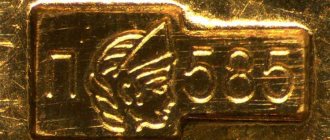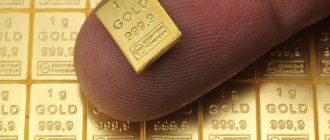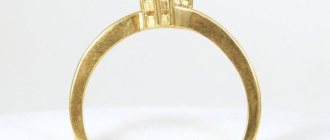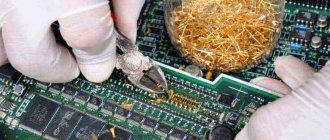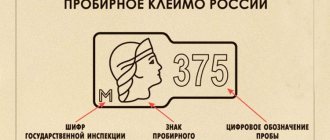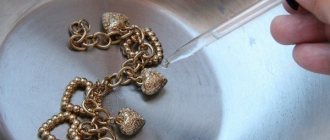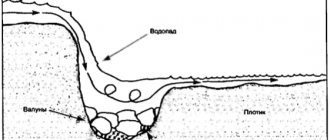What kind of sample is this
Alloys of 333 standard are called low-cork because of the lowest content of pure precious metal compared to other samples - only 33%. Accordingly, they are cheaper than other gold alloys.
Expert opinion
Vsevolod Kozlovsky
6 years in jewelry making. Knows everything about samples and can identify a fake in 12 seconds
In Russia, 333 gold products ceased to be produced after the collapse of the Soviet Union. In their place were products made from 375-karat alloys, the minimum permissible proportion of noble metal in which, according to the requirements of the state standard, is 37.5%.
Jewelry marked “333” can still be found today, but they were produced before the collapse of the USSR or abroad.
Features of 8K Alloy Products
The permissible content of a precious component in the material allows products made of precious metal to be classified as jewelry. The physical properties of the alloy make it possible to embody various motifs in products using openwork elements.
Jewelry gold 333 can often be found on the shelves of boutiques in Canada. This material is popular in Germany, which is why the alloy is called Germanic.
At one time, a material containing 1/3 of a noble metal was popular in the Czech Republic, where bronze was added as an alloy. The reliability of the alloy has been tested by many years of practice by craftsmen. There are still products that are more than 100 years old.
Despite the fact that 8-karat gold, according to craftsmen, is of low quality, it has a number of advantages. The material combines low cost and excellent physical properties, allowing the creation of products with intricate fine features that are difficult to produce from other alloys.
How is the purity of a precious metal determined?
The most accurate way to test gold is to apply a reagent to it. Based on the reaction of the reagent to the connection with the alloy, the percentage of precious metal content is determined. For example, the standard of gold from which the jewelry is made is determined in a pawnshop.
There are different types of reagents, each sample has its own. There are three main types:
- acidic,
- chlorine gold,
- potassium iodide.
Only a specialist can determine the gold sample. It is impossible to do this on your own at home.
How to check gold in a pawn shop using the visual method
So, you brought the jewelry to the pawnshop. First, it will be weighed on precision scales, and then examined through a magnifying glass with 6-10x magnification to check for the presence of two marks: hallmark and name mark.
Try
All jewelry made in Russia or imported into the country is stamped by the Assay Office. It guarantees that the product has been tested by the state and can be legally sold in Russia.
The hallmark is made in the shape of a spatula and contains the following symbols: A woman’s head in a kokoshnik (or a star, if the jewelry was made from 1953 to 1994).
- A number indicating the purity of the metal: 375, 500, 585, 750 (the number 585 means that the product is 58.5% pure gold).
- Letter code of the assay office that carried out the control.
Name person
The second sign that is checked at the pawnshop is the manufacturer’s name. It consists of four letters enclosed in a rectangular outline:
- The first letter indicates the year of manufacture (“P” - 2015, “S” - 2016, “T” - 2017).
- The second is the assay code (as on an assay mark).
- The last two letters are the manufacturer's code.
When examining the two marks, the appraiser pays attention to the clarity of the image. Genuine prints are distinguished by precision of lines, which is difficult to copy in artisanal conditions. If the jewelry has removable parts, a specialist examines each of them to find a simplified hallmark of the metal. Separately, it is checked whether an imprint cut from another piece of jewelry is soldered into the product.
Composition and properties
The composition of alloy “333” includes at least 33.3% pure metal and 76.3% alloy (impurities from various non-ferrous metals). The following are used as ligatures:
- copper,
- brass,
- nickel,
- silver,
- platinum,
- zinc,
- bronze,
- tin.
333 is common in Europe, where the standard metal color is yellow. Therefore, brass is used as an admixture for color correction.
Depending on the types of ligature present in the gold alloy, its melting point ranges from 900 to 1200 °C.
The alloy does not corrode and has high hardness.
General information about gold and 8 karat alloy
Gold is one of the precious and at the same time rare metals. Only in the computer game Klondike can the golden treasures of Ukhta be obtained by solving quests. In real life, its exploration and production involves enormous expenditures of mental and physical labor.
Pure gold is a very soft and malleable material by nature, making it difficult to use for jewelry. Craftsmen in the jewelry industry often experiment with alloys, adding an alloy to the solar metal.
Depending on the proportion of additional components, different gold samples are distinguished, measured in generally accepted systems:
- metric;
- carat;
- spool
333 standard gold contains 33.3% precious metal, which corresponds to 8 units of the karat system. The designation of this standard is similar in parameters to 375 standard, which is widely used in Europe for the manufacture of jewelry with an impressive assortment.
As a rule, copper, silver, palladium, and nickel are added to the composition as alloying components. The presence of additional material allows you to give the composition new physical properties.
Jewelry bronze, characterized by excellent fluidity, is used as a component to form the alloy. There are several varieties of bronze compositions used by craftsmen. The most popular is a composition containing 9 parts copper and 1 part tin. Depending on which metal used as the alloy will predominate in the composition of the alloy, its color may vary from yellow to red.
For example, a 5g engagement ring would contain:
- copper – 3 g;
- gold – 1.67;
- tin – 0.33.
In addition to rings, 8-karat gold is used in the manufacture of:
- bracelets;
- chains;
- accessories consisting of miniature parts.
Alloy color chart
Let us give an example of alloying gold using the most common impurities.
| Color | Gold, % | Silver, % | Copper, % |
| Red | 33,3 | 9,5 | 57,2 |
| Pink | 33,3 | 20 | 46,7 |
| Orange | 33,3 | 33,3 | 33,4 |
| Yellow | 33,3 | 44,5 | 22,2 |
| Yellow-green | 33,3 | 54,4 | 13,3 |
Sample systems: metric, carat, spool
The numerical designation of the sample is applied to all jewelry, but not all jewelry is marked according to a single system. Today, two sample systems are used - metric and carat, but in the last century in Russia the spool system was used.
Metric
Used in most countries of the world. The highest standard of the system is 1000th. For example, a 750 gold alloy contains 75% gold, the remaining 25% comes from other metals.
It is difficult to achieve the exact content of precious metal in an alloy, so GOST sets a remedium of 3 units for alloys containing gold, silver, and copper. That is, a gold alloy of 375 purity of gold should contain from 372 to 378 units (a deviation of 3 units in both directions is allowed). If the material contains nickel, then the remedium is 5 units. For an alloy of 585 standard, only a positive remedium of 5 units applies - deviations are allowed upward, but not downward.
Carat
Currently used in some European countries and the USA. The highest standard of the system is 24. Samples of 9, 14, 18, 22 are used - they show the content of pure precious metal in the composition. For example, 18 karat gold means that 18 of 24 parts are pure gold (this corresponds to 750 fine gold in the metric system). 1 carat in this system is equal to 9.744 grams.
Zolotnikovaya
Spool samples are old gold samples; they are no longer used. This system was used in Russia until 1927. The highest standard is 96. The units of measurement are:
- 1 pood = 40 pounds = 16.380 kilograms.
- 1 pound = 96 spools = 409.512 grams.
- 1 spool = 4.266 grams = 96 shares.
- 1 share = 0.044 grams.
For marking jewelry, samples of 56, 72, 92, 94 were used. If a sample of 56 was indicated, this meant that 1 pound (96 spools) of such an alloy contained 56 spools of pure gold (this corresponds to 585 samples of the metric system).
How many carats are in this sample?
In European countries, the content of pure gold in an alloy is indicated by carats, in Russia by fineness. 333 gold is 8 carat.
The table below presents three sample systems in which the precious metal content in the alloy is determined by the number of milligrams in 1 gram, carats and percentages.
| Metric Assay System, mg/1 g | 999 | 958 | 750 | 585 | 583 | 500 | 375 | 333 |
| Carat assay system, kar | 24 | 23 | 18 | 14 | 14 | 12 | 9 | 8 |
| Amount of precious metal in the alloy, % | 99,9 | 95,8 | 75 | 58,5 | 58,3 | 50 | 37,5 | 33,3 |
What does it mean?
If we translate into the European system of measuring gold content, then 333 samples will correspond to eight carats. This means that 33.3% of the alloy is pure gold, and the remaining 66.7% is impurities, or alloy.
333 gold
A ligature is added to a product to give it certain properties. Sometimes this may involve tweaking the appearance, such as making it white or rose gold. And also the ligature helps not only to reduce the cost of the product, but also to give it strength. Because 999 gold is a soft metal and can be easily deformed.
According to GOST standards, sample 333 is the minimum acceptable. In Soviet times, wedding rings were made from it. The products acquire a yellow-pink tint and are the most durable and durable. The following can be added as a ligature:
- Copper is a substance that significantly reduces the cost of a product.
- Brass.
- Nickel – Adding this metal in large quantities can have negative health effects.
- Zinc.
- Silver is also added to the alloy, often along with copper.
- Platinum is the only metal that, on the contrary, will increase the cost of the final product several times. But this situation is rarely observed.
Many people obtain gold containing 33.3% pure substance at home, independently extracting it from radio components or other elements. At the same time, cleaning and refining are poorly carried out. Or specially during smelting they add a lot of alloy, so that in the end the ingot turns out to be a little larger and enough for a homemade product.
How much is 1 gram of gold in this sample?
Prices vary in accordance with the quotation of the Central Bank of the Russian Federation for 999-carat gold. Based on it, the cost of 1 gram of gold of the required standard is calculated.
For 333 alloy, the minimum price is 870 rubles per gram. The cost changes along with the change in the price of pure gold.
| Price 999 standard according to the Central Bank | Market value of the sample today | Scrap price | Price in jewelry |
Rate of 1 gram of gold of 999 purity and calculation of the cost of purity 333
Prices for gold are set by the Central Bank of the Russian Federation, based on the fixing of prices on the London Stock Exchange. The price of a specific sample will depend on the cost of 1 gram of 999 precious metal, which is the highest.
The formula for calculation will be as follows: the metric value of the sample is divided by 1000, and then multiplied by the current price of 1 gram of 999 metal.
For 2021, the price of the highest alloy is about 3,740 rubles. Then the price of 333 alloys is 333/1000 * 3740 = 1245 rubles.
Gold bars
Recommendations for care and cleaning
To prevent products from losing their shine and scratches, you must follow simple rules:
- Avoid contact of perfumes and cosmetics with the surface of jewelry. Wash your jewelry periodically using a soft brush and soap.
- At least once a week, remove and wipe the products, check the operation of the locks and the presence of dirt.
Does gold darken
Gold does not darken, even the lowest grade. There are exceptions, but not because of the poor quality of the metal, but because of its reaction to the individual characteristics of the skin of the owner of the jewelry. This happens, as a rule, quite rarely.
However, if your jewelry is darkening or leaving marks on your skin, you should first check the quality of the metal.
Why do gold turn your fingers black?
Most often, the cause of blackening of fingers is a high percentage of copper impurities in the alloy of the product. A lot of copper is found in red alloys, and it is from them that fingers turn black. Most often, the reaction occurs to low-grade gold 333 and 375, but this is not a necessary phenomenon.
The appearance of stripes on the skin from gold
If you run gold jewelry over the skin, sometimes streaks remain on it. There is a myth that this indicates damage to a person. But this is just a consequence of a chemical reaction. The reason again lies in the impurities in gold. Streaks may appear due to their interaction with the skin that has produced sweat, or when a cream or other product is applied to the skin. Alloys react to perfumes, household chemicals, and acids.
Below watch a video about how to test gold using a probe:
Recommendations for the care and storage of antique USSR and low-grade German gold
Low-grade precious metal can leave dark spots on the skin due to its high impurity content. However, contrary to popular belief, such an alloy does not darken. Lack of regular care can cause jewelry to fade, but tarnishing is a myth.
Gold jewelry.
Jewelry works of the USSR Recommendations for care and storage for 333 samples will be as follows:
- Clean your jewelry periodically with washing powder dissolved in warm water. You can clean the products with soft brushes, and then wipe them with a thick-lint towel.
- Protect jewelry from contact with aggressive chemical elements, iodine, and cleaning agents.
- Store low-grade “German” gold in a dark place out of direct sunlight. Also, do not place the product near hot batteries.
These tips will help preserve the 333 precious metal's attractiveness and physical properties.
Reviews
Veronica, 23 years old: “Mom gave me a ring, an old one, 333 samples. It is beautiful, big, but impossible to wear. After a day of wear, marks appear on the skin and it looks ugly.”
Alina, 48 years old: “Since my youth I have been wearing 333 earrings, which I bought in the Czech Republic. They are comfortable, light, do not darken and are no different from other jewelry with a breakdown above. I’m very pleased.”
Alexey, 30 years old: “When we went to Europe, I bought 333 earrings as a gift for my wife. A week later my ears hurt and I couldn’t wear earrings. She wears other jewelry beautifully.”
